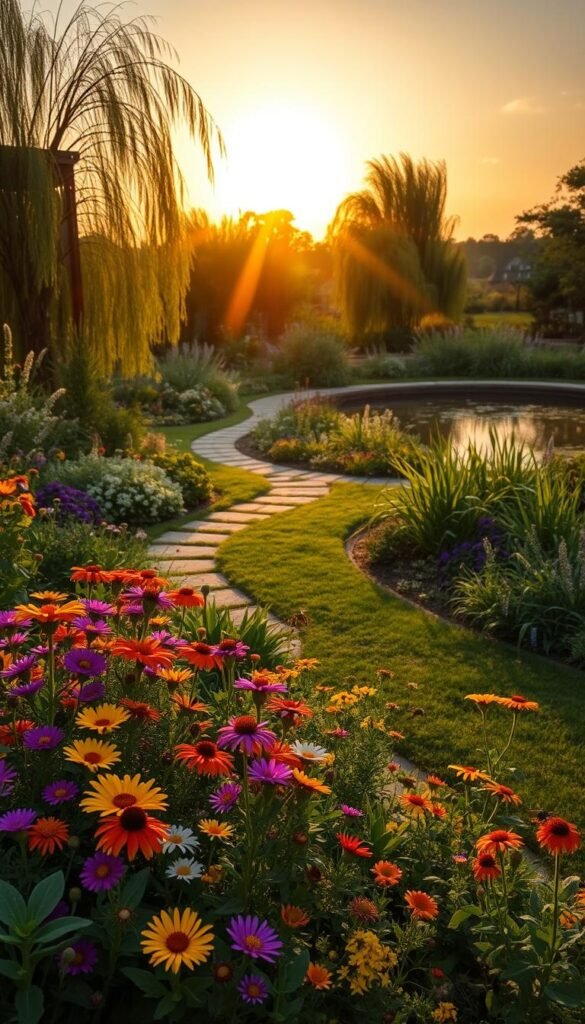Did you know over 75% of flowering crops depend on animals to reproduce? These tiny ecosystem partners work tirelessly, transferring pollen as they feed—a process that directly impacts your backyard harvests. According to the U.S. Fish and Wildlife Service, even small outdoor areas can become vital habitats for these creatures.
Your outdoor space holds untapped potential. Whether you’re working with a balcony or sprawling land, thoughtful choices in native plant gardening can create thriving environments. These living landscapes don’t just burst with color—they strengthen food systems by supporting essential cross-pollination.
Habitat loss has made residential areas crucial for species survival. By selecting specific blooms and arranging them strategically, you’ll attract winged visitors while boosting your own yields. Studies show gardens designed for ecological function can increase fruit production by up to 30% compared to conventional layouts.
This guide reveals how to balance visual charm with environmental impact. You’ll learn three distinct approaches that cater to different spaces and styles. From vibrant urban corners to serene countryside retreats, discover how your efforts connect to a global conservation movement while rewarding you with healthier plants and richer harvests.
Getting Started with Your Pollinator Garden
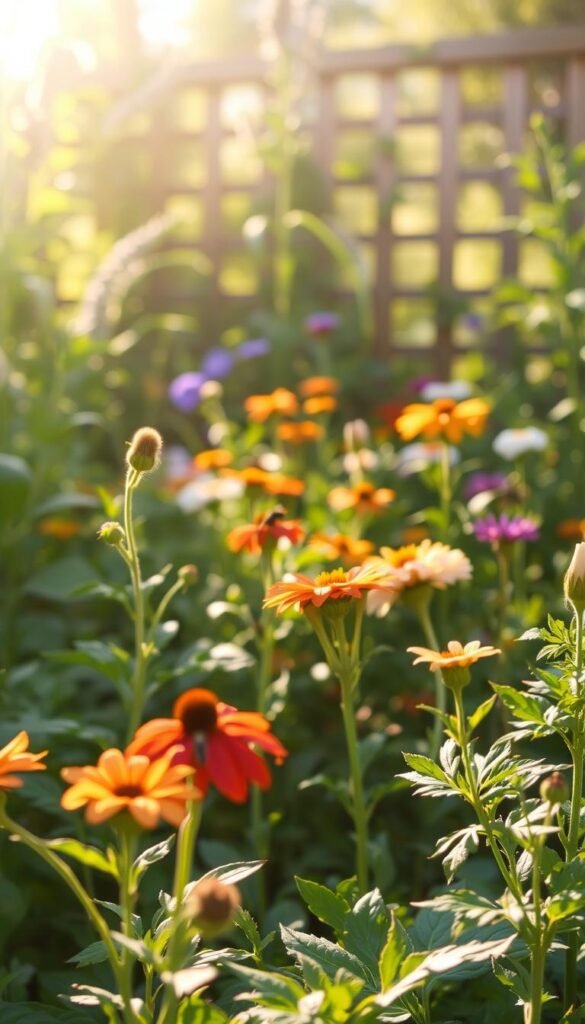
Every thriving habitat begins with understanding its foundation. Before selecting blooms, you’ll want to map your space like a detective—observing patterns and hidden potential.
Sunlight: The Secret Sauce for Success
Track how light moves across your area through the day. Morning rays differ from intense afternoon beams—some plants thrive in gentle dawn light, while others soak up midday heat. Use free apps like Sun Seeker to visualize patterns without guesswork.
Soil Secrets Revealed
Grab a handful of earth and squeeze. Does it crumble like coffee grounds (sandy) or form a dense ball (clay)? This quick test determines which plants will flourish.
“Soil type dictates water retention and root growth—it’s the unsung hero of any ecosystem,”
notes landscape designer Mara Winters.
Pair your findings with local climate data. Sheltered corners near fences create microclimates that extend planting seasons. Remember: Even a 2’x3′ patch can become a buzzing pitstop when planned thoughtfully.
Pollinator Garden Design: Creating a Haven for Bees, Butterflies, and Birds
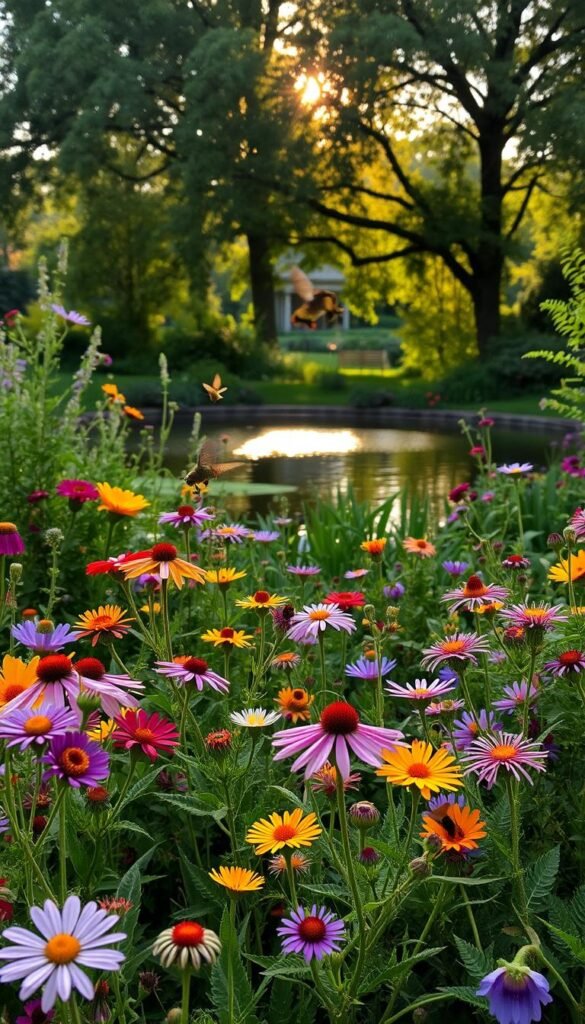
Nature’s pantry thrives when local ingredients lead the menu. The right plants act as both grocery stores and hotels for winged workers, offering nourishment and shelter through every life stage.
Selecting Native and Sustainable Plant Varieties
Local ecosystems evolved with specific native plants—think milkweed for monarch butterflies or goldenrod for native bees. These species have spent millennia perfecting partnerships with regional pollinators. To find yours:
- Contact your state’s native plant society for regional guides
- Visit a specialty nursery that labels pesticide-free options
- Check bloom times to ensure year-round food
Balancing Nectar, Pollen, and Seasonal Blooms
Bees need protein-rich pollen for larvae and sugary nectar for energy. Butterflies sip nectar through straw-like proboscises. Plan your flowers like a chef crafting a menu:
- Spring: Early bloomers like wild lupine
- Summer: Coneflowers and bee balm
- Fall: Asters and goldenrod
Pair these with container-friendly options for small spaces. Remember—organic perennials save time and provide reliable yearly feasts!
Choosing the Right Plants and Design Elements
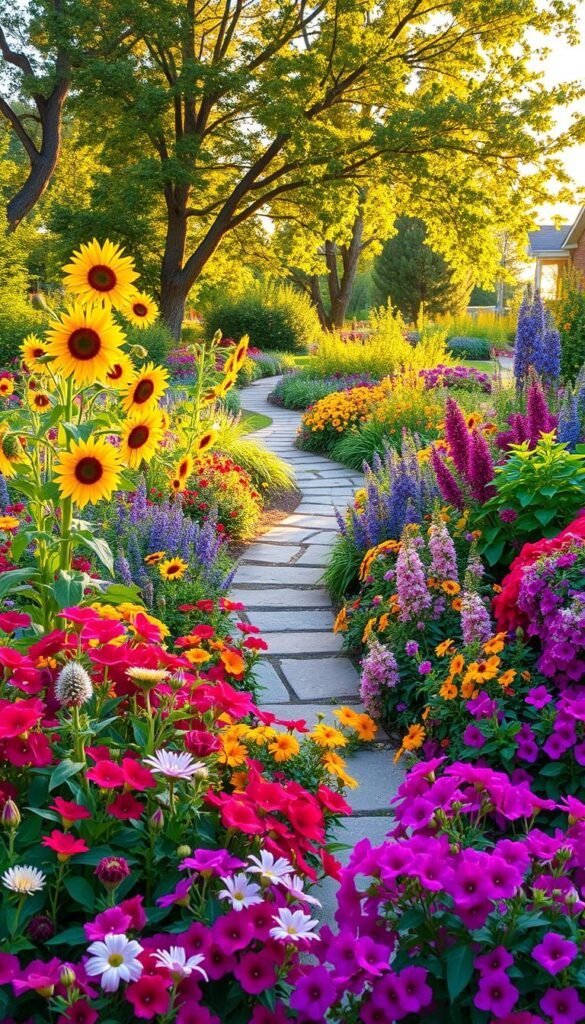
Your outdoor space becomes a living masterpiece when colors and shapes work in harmony with nature’s visitors. Strategic combinations turn ordinary beds into buzzing hubs where winged guests feast and flourish.
Color Palettes That Captivate
Bees flock to white, yellow, and blue blooms, while hummingbirds dive for red and orange trumpets. Butterflies adore purple coneflowers and zinnias’ rainbow hues. For maximum impact:
- Cluster same-color flowers in groups of 5-7
- Mix flat blooms (sunflowers) with tubular shapes (honeysuckle)
- Include foliage like silver sage for contrast
Signature Styles for Every Space
Three approaches transform your landscape into a pollinator paradise. The Dreamy Cottage style uses lavender coneflowers and wispy grasses for soft, natural charm. Lively Layers bursts with red salvias and golden yarrow, arranged in tiered heights.
Prefer clean lines? Curated Color focuses on two-toned schemes—try indigo butterfly bushes against white crabapples. Group plants in odd-numbered clusters near seating areas where you can watch bees dance across petals.
“Mass plantings create floral billboards that pollinators spot from afar,”
Pair early and late blooms to maintain nectar flow. Tall sun-loving varieties go behind shorter shade-tolerant ones. This layered look ensures every inch supports life while dazzling the eye.
Practical Steps for Building and Maintaining Your Garden
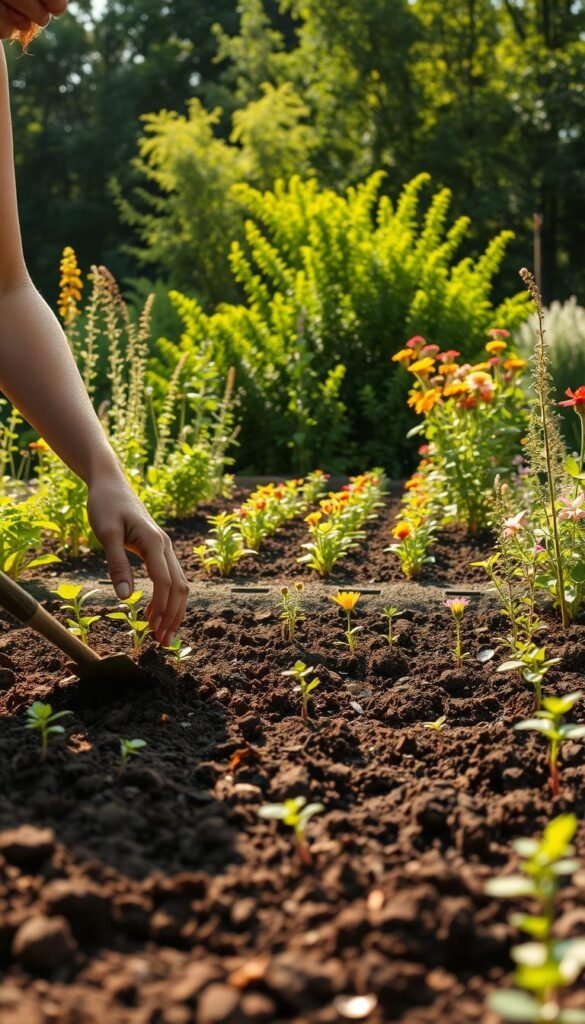
Ready to turn your vision into reality? Let’s dig into the hands-on work that transforms bare earth into a buzzing sanctuary. These proven methods ensure your efforts yield lasting results.
Preparing the Soil and Planting Techniques
Start by clearing existing grass or weeds. Use a spade to remove sod in sections if converting a lawn. Break up compacted soil with a garden fork—this improves drainage and root growth. Mix in 3 inches of compost to create nutrient-rich beds.
Choose seeds for cost-effective large areas or starter plants for instant impact. Scatter seeds in late fall or winter:
- October: Cover with ¼ inch soil
- February: Sprinkle over snow for natural watering
For nursery plants, wait until after frost. Dig holes twice as wide as the root ball. Gently loosen roots before placing them in the ground. Top with mulch to suppress weeds.
Effective Watering, Weeding, and Seasonal Maintenance
Water deeply once weekly instead of light daily sprays. This encourages stronger roots. Pull weeds by hand every 10 days, focusing on removing entire root systems.
Adjust care through the seasons:
- Spring: Divide overcrowded perennials
- Summer: Deadhead spent blooms
- Fall: Leave seed heads for birds
- Winter: Protect tender plants with burlap
Patience pays off—milkweed may take two years to flower, but bees will find other blooms while waiting. Track progress in a journal to celebrate each new visitor!
Wrapping Up Your Pollinator
Your journey from bare soil to buzzing ecosystem starts with a single bloom. By blending thoughtful planting strategies with nature’s rhythms, you’ll witness winged visitors transform your space into a lively sanctuary. For detailed guidance on species selection, explore these planting strategies that balance beauty and function.
Even compact areas shine when you use creative container arrangements. Pair trailing vines with upright blooms in pots—like purple verbena beside yellow coreopsis. Discover vibrant container combinations that thrive on patios or balconies.
Remember: Nature rewards patience. Track which flowers draw the most activity, and adjust your mix yearly. Herbs like thyme or basil add fragrance while feeding bees. Zinnias and marigolds offer low-maintenance color bursts.
Every seed planted strengthens local food webs and brings joy through fluttering wings. Start small, stay curious, and let your green space become part of a larger conservation story—one bloom at a time.

